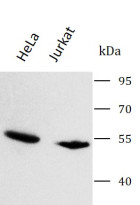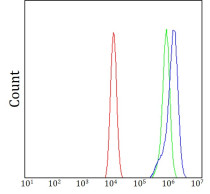ARG43941
anti-PILRA antibody
anti-PILRA antibody for ELISA,Flow cytometry,Western blot and Human
Overview
| Product Description | Rabbit Polyclonal antibody recognizes PILRA |
|---|---|
| Tested Reactivity | Hu |
| Tested Application | ELISA, FACS, WB |
| Host | Rabbit |
| Clonality | Polyclonal |
| Isotype | IgG |
| Target Name | PILRA |
| Antigen Species | Human |
| Immunogen | Human PILRA recombinant protein |
| Expression System | E.coli |
| Conjugation | Un-conjugated |
| Protein Full Name | Paired immunoglobulin-like type 2 receptor alpha |
| Alternate Names | PILRA; Paired Immunoglobin Like Type 2 Receptor Alpha; FDF03; Paired Immunoglobulin-Like Type 2 Receptor Alpha; Inhibitory Receptor PILR-Alpha; Cell Surface Receptor FDF03; Paired Immunoglobin-Like Type 2 Receptor Alpha |
Application Instructions
| Application Suggestion |
|
||||||||
|---|---|---|---|---|---|---|---|---|---|
| Application Note | * The dilutions indicate recommended starting dilutions and the optimal dilutions or concentrations should be determined by the scientist. |
Properties
| Form | Liquid |
|---|---|
| Purification | Affinity purified with Immunogen. |
| Buffer | 0.9% NaCl, 0.2% Na2HPO4 and 4% Trehalose. |
| Stabilizer | 4% Trehalose |
| Concentration | 0.5 mg/ml |
| Storage Instruction | For continuous use, store undiluted antibody at 2-8°C for up to a week. For long-term storage, aliquot and store at -20°C or below. Storage in frost free freezers is not recommended. Avoid repeated freeze/thaw cycles. Suggest spin the vial prior to opening. The antibody solution should be gently mixed before use. |
| Note | For laboratory research only, not for drug, diagnostic or other use. |
Bioinformation
| Database Links |
Swiss-port # Q9UKJ1 Human Paired immunoglobulin-like type 2 receptor alpha |
|---|---|
| Gene Symbol | PILRA |
| Gene Full Name | Paired Immunoglobin Like Type 2 Receptor Alpha |
| Background | Cell signaling pathways rely on a dynamic interaction between activating and inhibiting processes. SHP-1-mediated dephosphorylation of protein tyrosine residues is central to the regulation of several cell signaling pathways. Two types of inhibitory receptor superfamily members are immunoreceptor tyrosine-based inhibitory motif (ITIM)-bearing receptors and their non-ITIM-bearing, activating counterparts. Control of cell signaling via SHP-1 is thought to occur through a balance between PILRalpha-mediated inhibition and PILRbeta-mediated activation. These paired immunoglobulin-like receptor genes are located in a tandem head-to-tail orientation on chromosome 7. This particular gene encodes the ITIM-bearing member of the receptor pair, which functions in the inhibitory role. Alternative splicing has been observed at this locus and three variants, each encoding a distinct isoform, are described. |
| Function | Paired receptors consist of highly related activating and inhibitory receptors and are widely involved in the regulation of the immune system. PILRA is thought to act as a cellular signaling inhibitory receptor by recruiting cytoplasmic phosphatases like PTPN6/SHP-1 and PTPN11/SHP-2 via their SH2 domains that block signal transduction through dephosphorylation of signaling molecules. Receptor for PIANP. |
| Cellular Localization | Cell membrane, Membrane, Secreted |
| Calculated MW | 34 kDa |
| PTM | Glycoprotein, Phosphoprotein |
Images (2) Click the Picture to Zoom In







